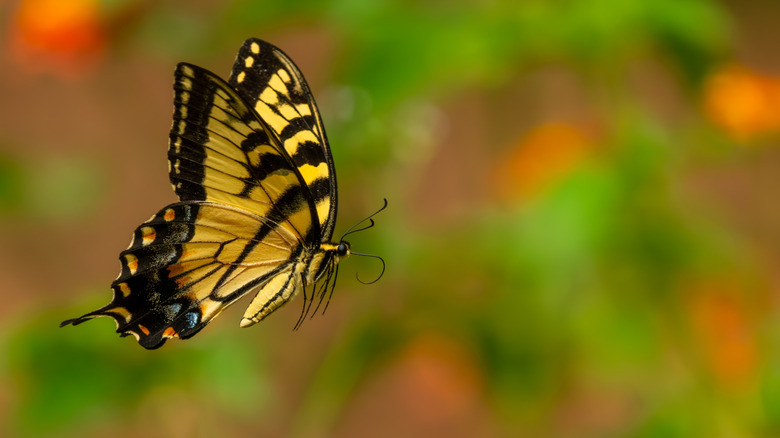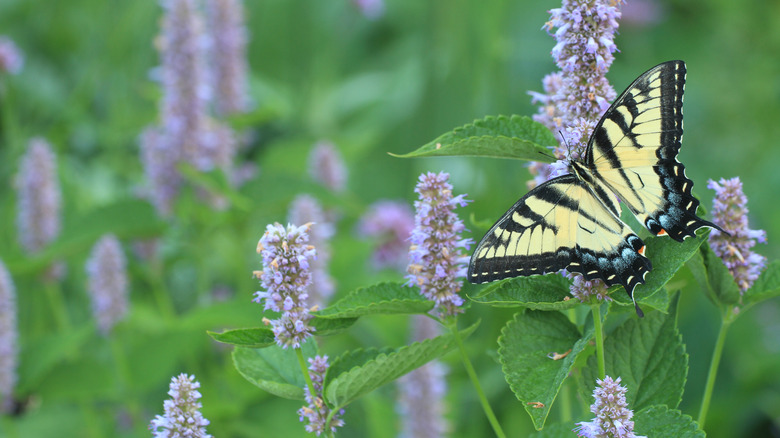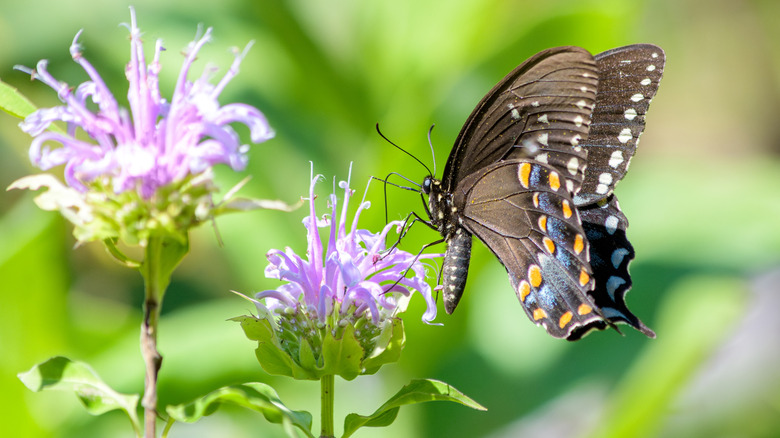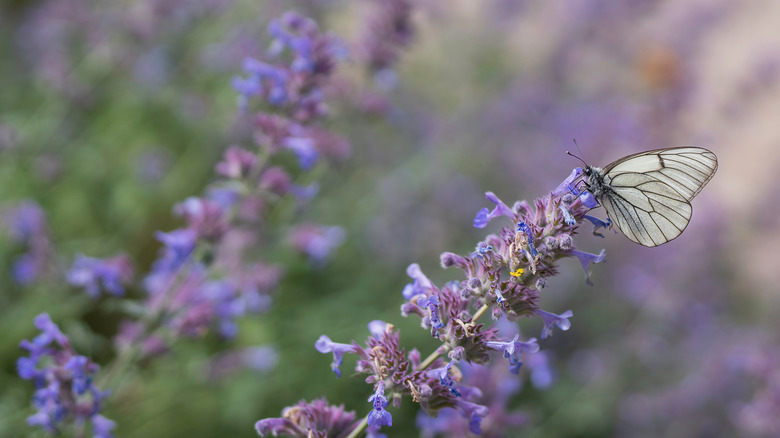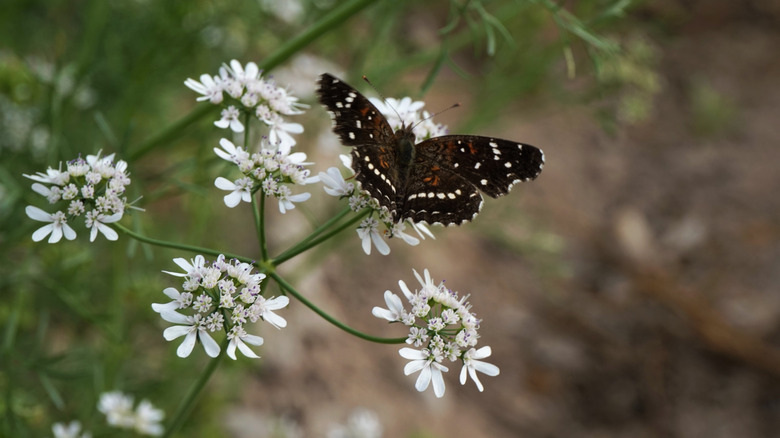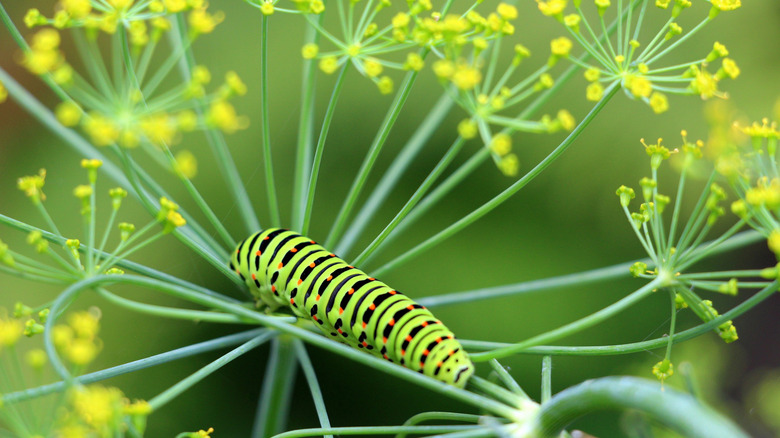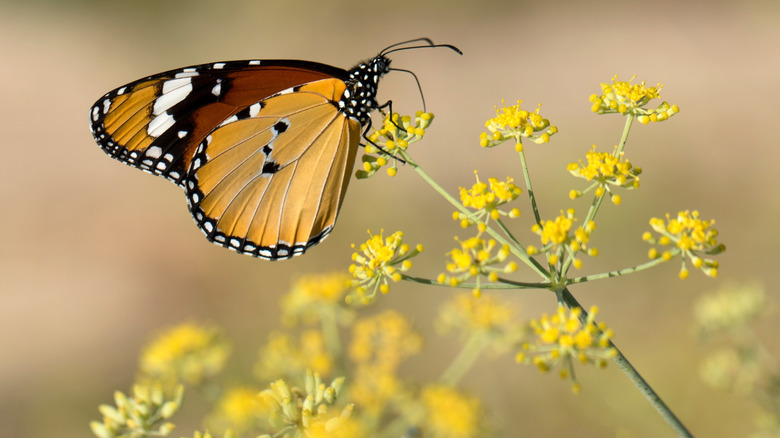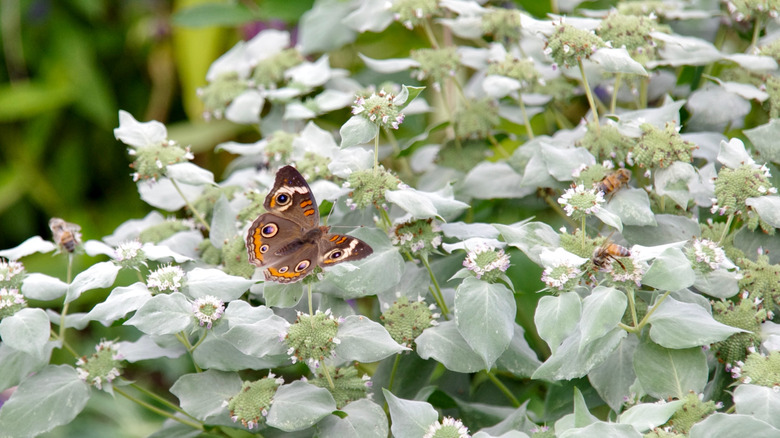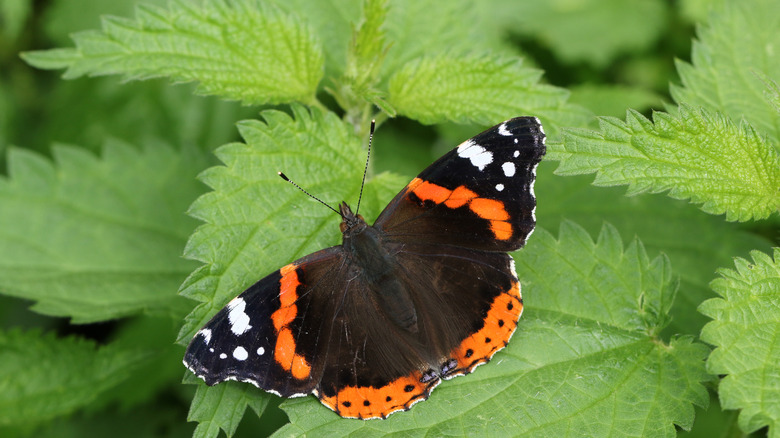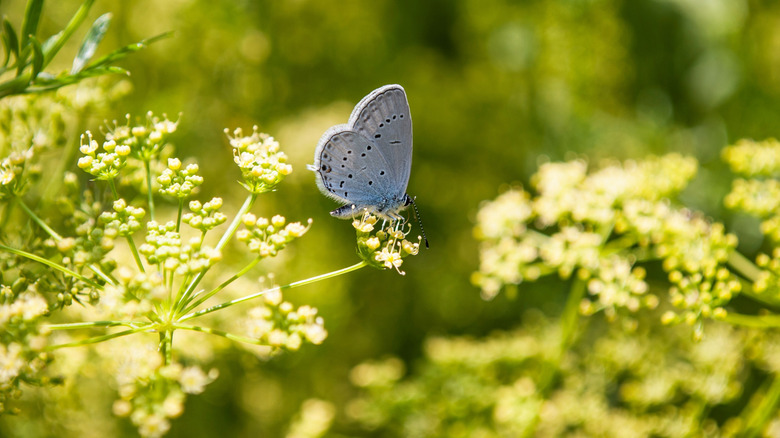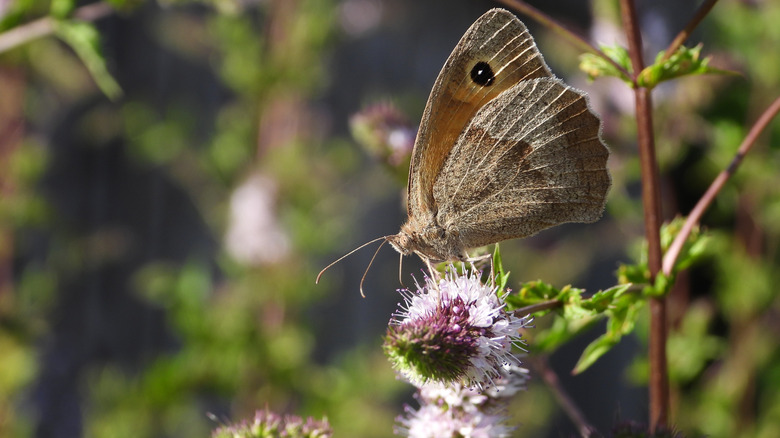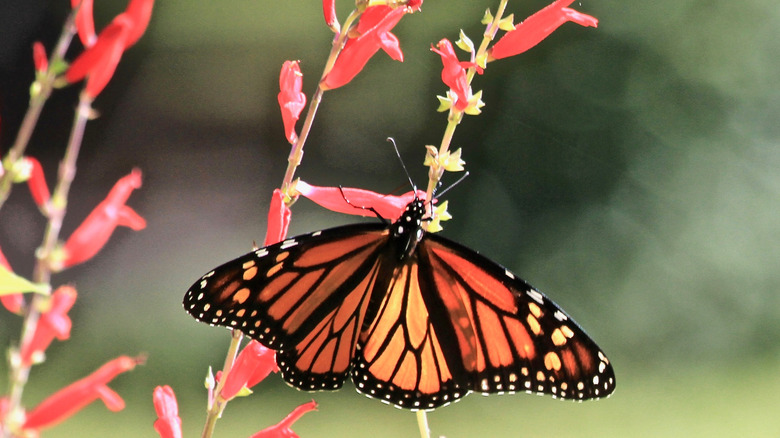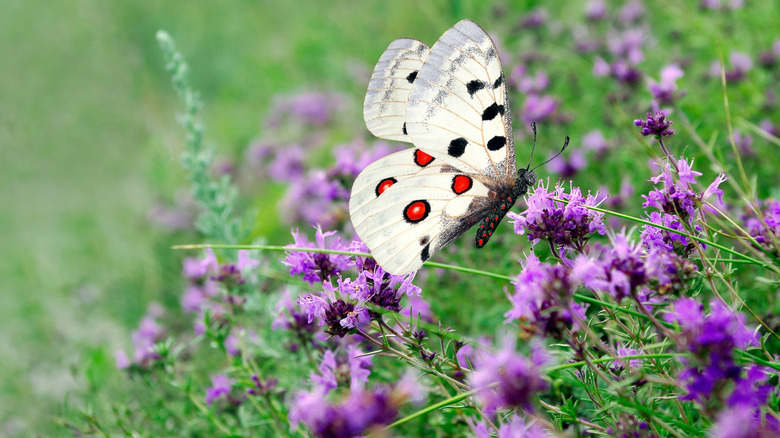Plant These 12 Fast-Growing Herbs To Turn Your Garden Into A Butterfly Paradise
Turning our backyards into butterfly safe havens can involve a list of selfless gardening acts. So, it's especially nice when one of those decisions also provides us with delicious ingredients for flavoring fresh summer meals or making homegrown herbal teas, such as dill, cilantro, and peppermint. There are many fast-growing herbs with culinary or medicinal properties that butterflies adore, and by providing a banquet of options, our backyards will turn into playgrounds of fluttering winged insects before we know it.
Butterflies and moths are attracted to aromatic herbs, either for the nectar-filled flowers or their foliage, when they provide food for their babies – also known as caterpillars. By growing a mix of fragrant herbs, like catmint and thyme, we can attract a variety of butterflies, as well as other pollinators like bees, wasps, and even hummingbirds. To get started, gardeners can choose a selection of quick-to-establish, annual, or perennial herbs that fit their growing conditions, palates, and landscape design preferences.
Anise hyssop
With lavender-colored flower spikes, anise hyssop (Agastache foeniculum) will fill your garden with hummingbirds and butterflies. Grown as a perennial in USDA Hardiness Zones 5 to 9, this fragrant plant is both deer-resistant and drought-tolerant. Gardeners should grow anise hyssop in full sun to partial sun, in dry or moist soil with good drainage. Both the leaves and the flowers are edible, so get ready to make some delicious homegrown herbal tea.
Bee balm
With globe-shaped flower heads covered with pink, purple, red, or white tubular blooms, bee balm (Monarda spp.) performs as an excellent wildlife plant while also providing the makings of a lovely herbal tea. Grow bee balm plants in full sun and keep their well-draining soil moist. These plants that will fill your garden with a variety of butterflies and other pollinators are perennial in Zones 4 to 9.
Catmint
Catmint (Nepeta x faassenii) may be catnips' less exciting relative — at least for cats — but this herb is a thrill as far as butterflies are concerned. These beautiful bugs will forage from the many small blue blooms on catmint's flower spikes. Caring for catmint plants includes growing them in full sun, in lean, well-drained soil. Tolerant of dry soil once established, this herb can also be used to make tea and can be grown as a perennial in Zones 5 to 9.
Cilantro
An annual garden herb that is either cherished or despised as a culinary ingredient, cilantro (Coriandrum sativum) plants produce umbrella-shaped flower heads that pollinators, such as butterflies, love to sit on while foraging for nectar. Plus, cilantro and its relative dill are companion herbs that are a powerhouse duo for garden pest control, thanks to their ability to attract a plethora of beneficial insects. A spring-sown plant, cilantro needs full sun, well-draining soil, and sparse water once established. Grab some of the leaves and throw them into your salsa, but let the flowers bloom for the bugs.
Dill
Another flavorful herb you'll want to add to your garden in spring is dill (Anethum graveolens), a fast-growing annual that thrives in full sun and soils that are nutrient-poor and fairly dry. With umbrella-shaped flower heads, pollinators flock to this member of the carrot family. In particular, swallowtail butterflies love dill since it provides them a place to lay their eggs and feed their babies. Dill foliage makes great homemade tzatziki, and after the flowers are done feeding beneficial insects, you can collect dill seeds for pickles.
Fennel
Like dill, fennel (Foeniculum vulgare) is a plant that swallowtail caterpillars can feed on during their lifecycle before transforming into beautiful butterflies. Perennial in Zones 4 to 9, this licorice-flavored herb needs full sun, well-draining soil, and moist conditions. However, before planting this common herb in your garden, keep in mind that fennel is allelopathic – able to prevent other plants from thriving — so consider planting it separately or in a container.
Mountain Mint
Butterflies love it, but they're not the only ones — expect to bring all sorts of beneficial bugs to your garden with mountain mint (Pycnanthemum spp.). As plants native primarily to the eastern and central regions of the US and Canada, these silvery perennials can be grown in full sun to partial shade in Zones 4 to 8, in areas where the soil drains well and remains moist. When you're ready to take a break from admiring the incredible number of pollinators gathered on mountain mint's strange blooms, gather some of its leaves to make a spearmint-flavored tea.
Nettle
Stinging nettles (Urtica spp.) serve as host plants for certain butterflies, such as painted ladies. To attract butterflies with these sometimes-prickly but edible plants, grow these perennial herbs in rich, moist soil under full sun in Zones 5 to 9. And, if you're looking for one more excuse to add nettles to your landscape, you can turn this weed into a DIY fertilizer and use it to water your garden.
Parsley
As a member of the carrot family, parsley (Petroselinum crispum) is an easy-to-grow herb that'll attract more black swallowtail butterflies to your garden. Need to know how to grow and care for your own parsley plant? Start your patch in soil that drains well but has plenty of organic matter, and make sure this herb gets a good soak once a week. Although often grown as an annual, this is a biennial plant – and if you grow flat-leaf parsley, it will easily self-seed, creating a perpetual source of this tabbouleh ingredient.
Peppermint
Peppermint (Mentha x piperita) isn't just a popular winter flavoring – butterflies love foraging from the flower-covered spikes of this aggressive grower. If you're wondering how to grow and take care of peppermint plants, these herbs are perennials in Zones 5 to 9 and can grow in full sun to part shade in moist soils with good drainage. Don't forget you can also use the leaves to make your own peppermint tea.
Pineapple Sage
Pineapple sage (Salvia elegans) is a delicious-smelling herb that hummingbirds and butterflies flock to for its eye-catching, trumpet-shaped red blooms. Hardy only in Zones 8 to 10, gardeners in locations with cooler winters can grow it as an annual. This fragrant herb needs full sun or part shade and well-draining soil that is only occasionally dry.
Thyme
Thyme (Thymus spp.), a perennial that's hardy in Zones 5 to 9, brightens the garden with nectar-filled flowers, a strong attraction for butterflies. When growing thyme, choose a location that receives full sun and has excellent drainage, preferably with coarse soil that dries out quickly. These evergreen perennial herbs make great ground covers and will offer you a ready supply of leaves to sprinkle on Mediterranean-inspired dishes. Although not all types of thyme grow quickly, there are some fast growers among its ranks, including creeping thyme, caraway thyme, and mother of thyme.
